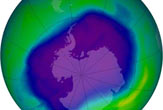
During its seasonal peak, the ozone hole set a record this year, scientists reported today.
The ozone hole, which covers much of Antarctica, is thought to be caused by human-produced compounds which release chlorine and bromine. Chemical reactions high in the atmosphere cause these gases to destroy ozone. The presence of the hole—actually an area of significantly reduced ozone—means that the ultraviolet radiation from the sun reaches Earth's surface in greater amounts.
The ozone hole, which covers much of Antarctica, is thought to be caused by human-produced compounds which release chlorine and bromine. Chemical reactions high in the atmosphere cause these gases to destroy ozone. The presence of the hole—actually an area of significantly reduced ozone—means that the ultraviolet radiation from the sun reaches Earth's surface in greater amounts.
"From Sept. 21 to 30, the average area of the ozone hole was the largest ever observed, at 10.6 million square miles," said Paul Newman, atmospheric scientist at NASA's Goddard Space Flight Center, Greenbelt, Md. If the stratospheric weather conditions had been normal, the ozone hole would be expected to reach a size of about 8.9 to 9.3 million square miles, about the surface area of North America.
This year's average broke the 2003 record of 10.5 million square miles.
This year also included a daily record tied with Sept. 9, 2002. The peak size was 11.4 million square miles on Sept. 24 this year, Newman told LiveScience.com. "That's the record single-day average."
Newman and his colleagues averaged the last 10 days of September, peak dates for ozone hole area, for the last quarter of century.
"We go all the way back to 1979," Newman said. "If you go before 1979 there was no ozone hole."
By Sara Goudarzi |
